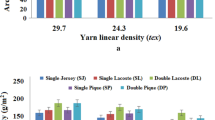Abstract
Thermal comfort parameters of knitted fabrics such as thermal resistance and liquid transfer can be enhanced by combining hydrophilic and hydrophobic functional yarns as double-face fabrics. This study aims to investigate thermal conductivity (Alambeta Parameters), permeability (air permeability and Permetest Parameters) and liquid management characteristics of double-face knitted fabrics for which functional yarns such as Thermosoft®, Nilit Heat®, Viloft® and wool were combined with standard polyester (PET) and polypropylene (PP) by a false rib structure. According to the results of 11 fabrics-s is necessary, Nilit Heat®/PP (inner/outer) fabric has advantages for breathability, warmer sensations as a result of its minimum thermal absorption, conductivity and diffusion. Wool/PET can be suggested more for liquid management properties with its branched structure besides its higher thermal resistance and air permeability values. Both structures including hydrophilic or functional inner surfaces touching the skin can be suggested for a cold protective clothing to enable stable insulation and dryness.
Similar content being viewed by others
References
https://www.technavio.com/ (Accessed October 20, 2020).
D. Uttam, Int. J. IT., 2, 34 (2013).
S. S. Chaudhari, R. S. Chitnis, and R. Ramkrishan, Man-Made Text. India J., 5, 166 (2004).
S. M. Saundri and S. Kavitha, Int. J. Sci., 4, 1010 (2015).
J. E. Ruckman, J. Fash. Mark. Manag., 9, 122 (2005).
S. V. Purane and N. R. Panigrahi, Autex Res. J., 3, 148 (2007).
S. A. Hosseini and M. Valizadeh in “Improving Comfort in Clothing” (G. Song Ed.), The Textile Institute, CRC Press, Woodhead Publishing Limited, Chapter 2, pp.67–68, Cambridge, 2011.
Nilit Fibers, Thermo Insulating Yarn That Captures and Conserves Natural Body Heat, to Warm Wearers from the Inside Out, http://www.nilit.com/fibers/brands-nilit-heat.asp (Accessed June 1, 2021).
C. S. Kim, D. Dissertation, Kansas State University, Kansas, 1995.
M. A. Morris, Text. Res. J., 25, 766 (1955).
L. Schacher, D. C. Adolphe, and J. Y. Drean, Int. J. Clothing Sci. Technol., 2, 84 (2000).
S. Yoo and R. L. Barker, Text. Res. J., 75, 523 (2005).
R. S. Rengasamy, B. R. Das, and Y. B. Patil, J. Text. Inst., 100, 507 (2009).
R. M. Laing, B. A. MacRae, C. A. Wilson, and B. E. Niven, Text. Res. J., 81, 1828 (2011).
M. Matusiak and W. Sybilska, J. Text. Inst., 107, 842 (2016).
S. Afzal, A. Ahmad, A. Rasheed, M. Mohsin, F. Ahmad, and Y. Nawab, Therm. Sci., 21, 2393 (2017).
J. M. Souza, S. Sampaio, W. C. Silva, S. G. Lima, A. Zille, and R. Fangueiro, Text. Res. J., 88, 275 (2018).
W. Seames, B. Ficek, and W. Line, Int. J. Clothing Sci. Technol., 19, 349 (2007).
M. G. Cil, U. B. Nergis, and C. Candan, Text. Res. J., 10, 917 (2009).
Q. Chen, J. Fan, M. Sarkar, and G. Jiang, Text. Res. J., 80, 568 (2010).
H. G. Atasağun, E. Öner, A. Okur, and A. R. Beden, J. Text. Inst., 106, 523 (2015).
O. Troynikov and W. Wardiningsih, Text. Res. J., 81, 621 (2011).
L. Zhou, X. Feng, Y. Du, and Y. Li, Text. Res. J., 77, 951 (2007).
I. Konopov, L. Oggiano, G. Chinga-Carrasco, O. Troynikov, L. Sætran, and F. Alam, Procedia Eng., 2, 2837 (2010).
Y. Park, Fiber Polym., 17, 477 (2016).
A. Bivainytė, D. Mikučionienė, and P. Kerpauskas, Mater. Sci., 18, 167 (2012).
M. Manshahia and A. Das, High Active Sportswear-a Critical Review, 39, 441 (2014).
Y. Jhanji, D. Gupta, and V. K. Kothari, J. Text. Inst., 106, 663 (2015).
C. Viorica, Ann. Univ. Oradea, Fasc. Textile Leatherwork, 15, 47 (2014).
T. Suganthi and P. Senthilkumar, Indian J. Fibre Text. R., 43, 9 (2018a).
T. Suganthi and P. Senthilkumar, J. Ind. Text., 47, 1447 (2018).
M. Z. Khan, S. Hussain, H. F. Siddique, V. Baheti, J. Militky, M. Azeem, and A. Ali, Tekst Konfeksiyon, 28, (2018).
B. Sathish Babu, P. Senthil Kumar, and M. Senthil Kumar, J. Ind. Text., 49, 1078 (2020).
S. M. Udaya Krithika, C. Prakash, M. B. Sampath, and M. Senthil Kumar, Fibres Text. East. Eur., 28, 50 (2020).
A. P. D’Silva, C. Greenwood, S. C. Anand, D. H. Holmes, and N. Whatmough, J. Text. Inst., 91, 383 (2000).
C. Keiser, C. Becker, and R. M. Rossi, Text. Res. J., 78, 604 (2008).
Basyazicioglu Textile/Bamen, ThermoSoft Yarn, http://www.bamen.com.tr/production/list (Accessed January 1, 2020).
Suedwolle Group, Technical Brochure, https://www.suedwollegroup.com/innovation/about-yarn/ (Accessed November 1, 2020).
Kelheim Fibres, The Flat Fibre for Moisture Management and Natural Dry Feel in Textiles, http://kelheim-fibres.com/en/viskosefaser/viloft-staplefibre/ (Accessed November 1, 2020).
Nilit Fibers, Thermo Insulating Yarn That Captures and conServes Natural Body Heat, to Warm Wearers from the Inside Out, http://www.nilit.com/fibers/brands-nilit-heat.asp (Accessed December 1, 2020).
L. Fourt, A. M. Sookne, D. Frishman, and M. Harris, Text. Res. J., 21, 26 (1951).
P. Cuden and U. S. Elesini, Acta Chim. Slov., 57, 957 (2010).
O. N. Tatlı, MSc Dissertation, Istanbul Technical University, Istanbul, 2007.
R. M. Laing, B. E. Niven, R. L. Barker, and J. Porter, Text. Res. J., 77, 165 (2007).
T. B. Üte, N. Oğlakçıoğlu, P. Çelik, A. Marmaralı, and H. Kadoğlu, Tekst Konfeksiyon, 18, 191 (2008).
Moisture Management Tester Operation Manual, Quick Quantitative Determination of Fabric Moisture Management Properties, Version 3.06, SDL Atlas Company, 2005.
B. K. Sirková and E. Moučková, Autex Res. J., 18, 385 (2018).
C. Prahsarn, PhD Dissertation, NCSU, Raleigh, 2001.
Acknowledgements
This work was supported by Suleyman Demirel University under Grant Number FYL-2009-7071. Ozanteks Textile Co. kindly provided sample production. We want to thank to both for their contribution.
Author information
Authors and Affiliations
Corresponding author
Rights and permissions
About this article
Cite this article
Kaplan, S., Yilmaz, B. Thermal Comfort Performances of Double-face Knitted Insulation Fabrics. Fibers Polym 23, 537–545 (2022). https://doi.org/10.1007/s12221-021-0045-7
Received:
Revised:
Accepted:
Published:
Issue Date:
DOI: https://doi.org/10.1007/s12221-021-0045-7




